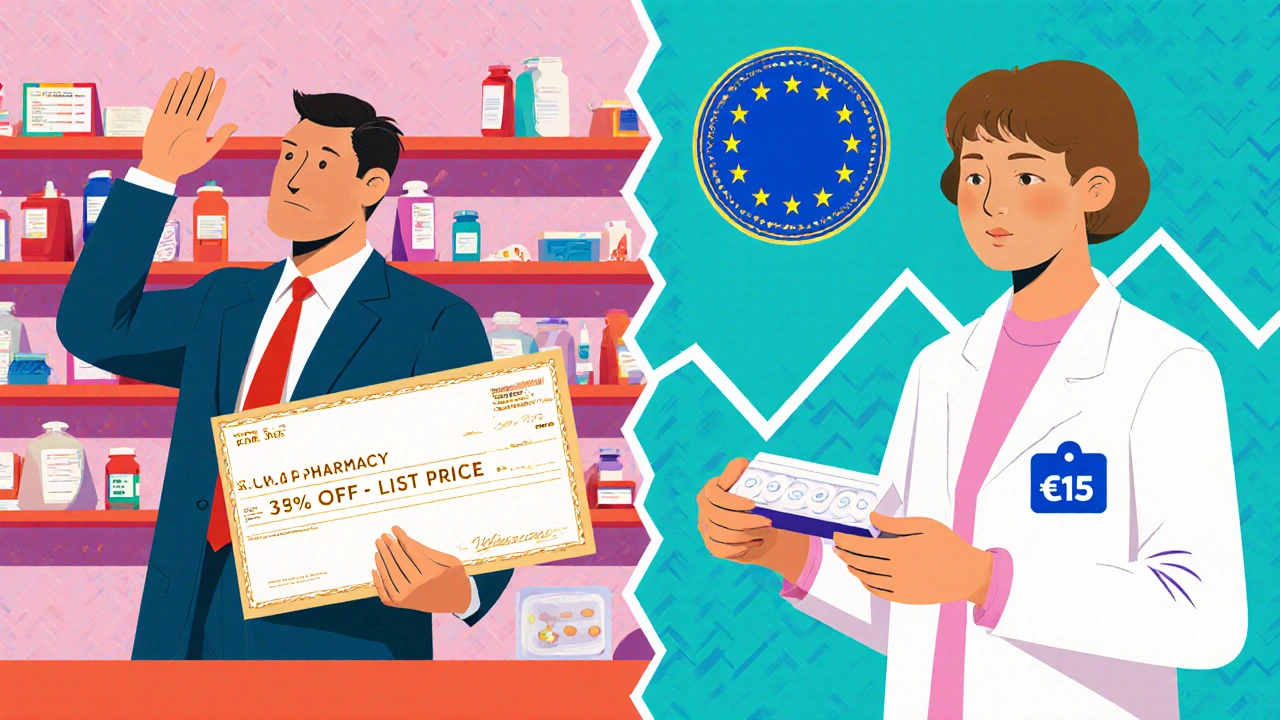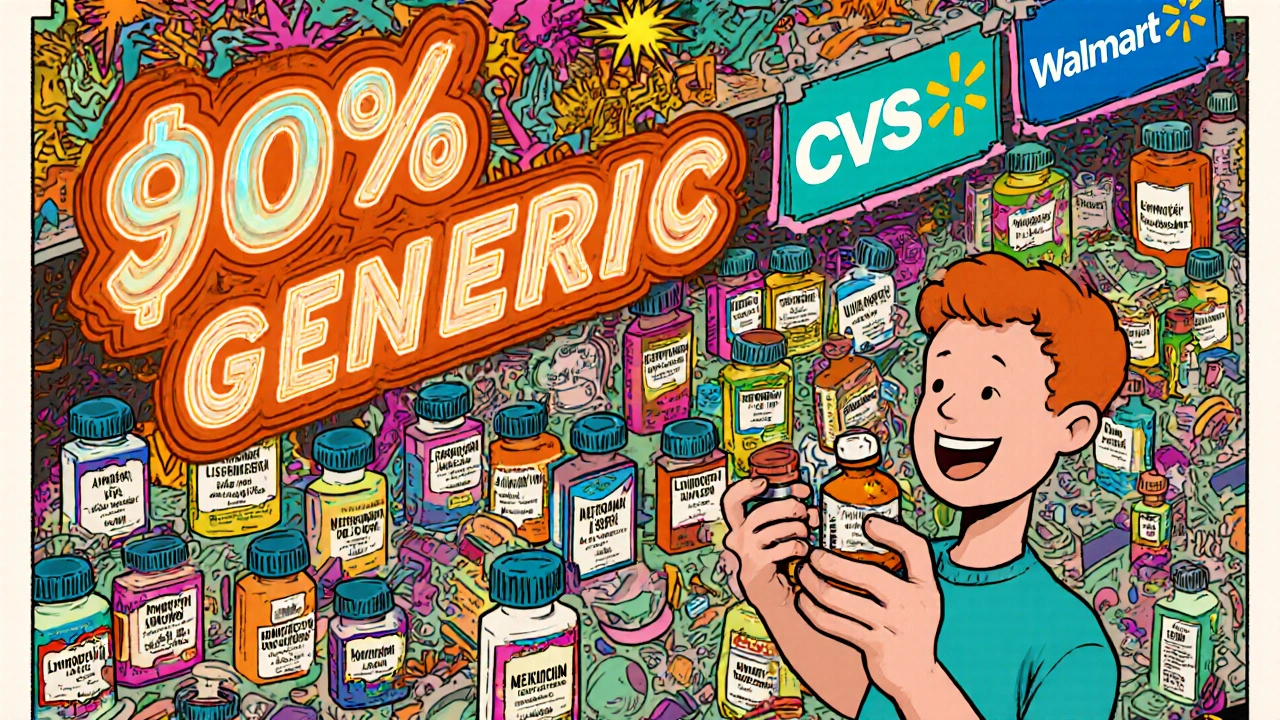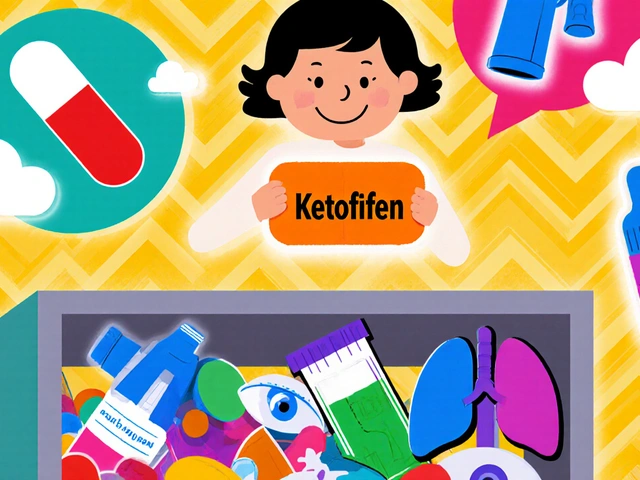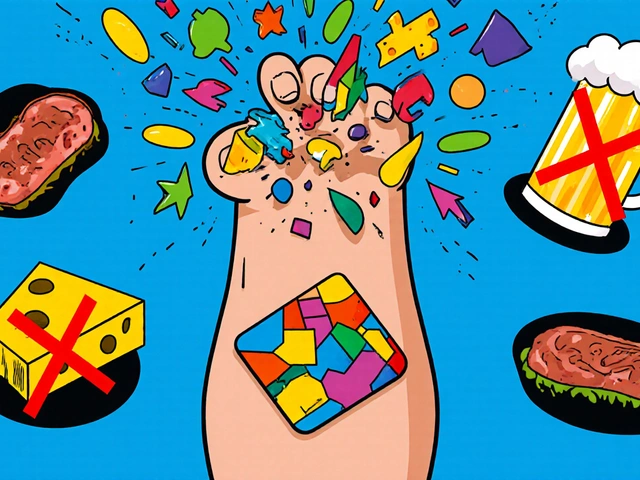It’s a common surprise for Americans traveling in Europe: they walk into a pharmacy to buy a simple generic pill - say, lisinopril for high blood pressure - and the price is three to five times higher than what they pay back home. Meanwhile, Europeans are stunned when they hear how much Americans pay for brand-name drugs like Ozempic or Jardiance. The truth is, the U.S. and Europe don’t just have different drug prices - they have completely different systems that create this strange paradox: Americans pay less for generics, but way more for brand-name drugs.
How Much Less Do Americans Pay for Generic Drugs?
In 2022, the U.S. Department of Health and Human Services found that Americans paid, on average, 33% less for generic drugs than people in 33 other OECD countries. That means if a month’s supply of generic metformin costs $15 in Germany, it might cost just $10 in the U.S. - sometimes even less. In fact, in many cases, generic drugs in the U.S. cost under $5 with insurance, and often $0 to $10 out-of-pocket under Medicare Part D.
Why? Because the U.S. generic market is a high-volume, low-margin race to the bottom. There are dozens of manufacturers competing for the same drug - Teva, Mylan, Sandoz, and dozens of smaller players. Pharmacy Benefit Managers (PBMs) and big pharmacy chains like Walmart, CVS, and Costco use their buying power to drive prices down. Some generic drugs are sold at a loss just to get customers in the door. That’s why you can get 90 pills of generic amoxicillin for $4 at Walmart.
But here’s the catch: those low prices aren’t always sustainable. When too many companies exit a market because the price is too low, shortages happen. That’s what occurred with generic injectable drugs and some antibiotics in recent years. One manufacturer gets a monopoly, then raises prices. It’s a cycle: too low → no supply → monopoly → spike.
Europe’s System Is Built to Keep Generic Prices Higher
In Europe, only about 41% of prescriptions are for unbranded generics - far lower than the U.S.’s 90%. Why? Because European governments don’t encourage substitution the same way. In France, a pharmacist can’t switch your brand-name drug to a generic without your doctor’s OK. In Germany, pharmacists can substitute, but many patients stick with the brand because of trust or habit.
More importantly, European countries use centralized price controls. Governments negotiate directly with drugmakers and set fixed prices. They often use reference pricing - meaning they look at what other countries pay and set their price around the average. If Germany pays $10 for a drug, France won’t pay $20. That keeps prices stable, but it also removes the pressure to compete on price. No one’s racing to be the cheapest. So even though manufacturing costs are similar, European generic prices stay higher.
Plus, European manufacturers don’t have the same scale. In the U.S., a single PBM can negotiate for hundreds of millions of prescriptions. In Europe, each country negotiates separately. That means less leverage for volume discounts.
Why Are Brand-Name Drugs So Much More Expensive in the U.S.?
While generics are cheaper in the U.S., brand-name drugs are the opposite. The same 2022 HHS report found that Americans pay 422% more for brand-name drugs than people in other OECD countries. Even after accounting for hidden rebates, U.S. prices are still over 300% higher.
Why? Because the U.S. doesn’t negotiate drug prices. Medicare, which covers over 60 million Americans, was banned from negotiating drug prices until the Inflation Reduction Act of 2022. Even now, only 10 drugs are being negotiated in the first round - and those prices are still 1.6 to 3.9 times higher than in other countries. For example, Medicare negotiated Jardiance at $204 per month - while the average in other countries was $52.
The reason? The U.S. market funds global drug innovation. About 60-70% of all new drug research is paid for by U.S. sales. Drug companies charge high prices here because they know other countries won’t pay much. Europe, Canada, Japan, and Australia use price controls to keep costs low - and they rely on the U.S. to shoulder the R&D burden. As Dana Goldman from USC put it: “Other countries are free-riding on the United States when it comes to drug discovery.”

The Hidden System: How PBMs and Rebates Distort the Real Price
Here’s where it gets confusing. The price you see on a drug label - the “list price” - is rarely what anyone pays. In the U.S., PBMs negotiate rebates of 35-40% off that list price from drugmakers. But those rebates go to insurers and PBMs, not patients. So a drug might have a $500 list price, but the net price after rebates is $300. The patient still pays $10 or $25 based on their plan’s copay.
In Europe, there’s no rebate system. The price you see at the pharmacy is the price the government pays. No middlemen. No hidden deals. That’s why Europeans don’t understand why Americans complain about high drug prices - they don’t see the list price. They see the final price, which is low for generics and controlled for brands.
This system makes it hard to compare prices directly. A U.S. generic might have a $100 list price, but after rebates, the net price is $25. In Germany, the same drug has a $40 list price with no rebates. So the U.S. net price is lower, but the list price looks insane. That’s why international comparisons often mislead people.
What’s Changing? Medicare Negotiations and Global Pressure
The U.S. is starting to change. The Inflation Reduction Act lets Medicare negotiate prices for 10 drugs in 2026, 15 in 2027, and up to 20 by 2029. Early results show negotiated prices are still higher than abroad - but they’re lower than before. For example, Stelara’s price dropped from $7,000 to $4,490 per year under Medicare. That’s still more than double what Germany pays, but it’s a step toward alignment.
Meanwhile, Europe is watching closely. If the U.S. starts cutting brand-name prices, drugmakers might raise prices elsewhere to make up the loss. Alexander Natz of EUCOPE warned that if the U.S. adopts a “most favored nation” policy - forcing U.S. prices to match the lowest international price - manufacturers could raise prices in Europe by 20-30% to compensate.
There’s also pressure from within the U.S. to fix the PBM system. Critics say PBMs profit from the gap between list price and net price. Some lawmakers are pushing for transparency: require rebates to go to patients, not middlemen. But so far, nothing has changed.

What This Means for You
If you’re in the U.S. and taking generics, you’re getting one of the best deals in the world. For $5 a month, you can get life-saving medications like statins, blood pressure pills, or diabetes drugs. Don’t assume you’re being overcharged - the system works for generics.
If you’re on a brand-name drug, you’re paying more than most of the world. That’s not because you’re being targeted - it’s because the U.S. system was designed to fund innovation. But that’s starting to shift. Medicare negotiations, public pressure, and new laws could bring brand-name prices down over the next five years.
If you’re in Europe and wondering why your generic costs more - it’s not because your system is broken. It’s because your government chose stability over competition. You get predictable prices, fewer shortages, and no surprise bills. But you also pay more for the same pill.
Bottom Line: Two Systems, One Global Market
The U.S. and Europe aren’t just different in drug pricing - they’re playing different games. The U.S. uses market competition for generics and lets the market set prices for brands. Europe uses government control for everything. Neither system is perfect. The U.S. has shortages and hidden costs. Europe has slower access to new drugs and higher out-of-pocket costs for non-generics.
But here’s the key takeaway: the U.S. generic market is uniquely efficient. No other country comes close to matching its low prices for off-patent drugs. And that’s not going away anytime soon. Even as brand-name prices come under pressure, the structure of the U.S. generic market - with its volume, competition, and PBM leverage - makes it nearly impossible for Europe to replicate.
So if you’re an American: thank the system for your $4 generics. If you’re European: understand why your system keeps prices higher - and why it might not change. And if you’re anywhere else: recognize that the U.S. is still the engine of global drug innovation - and that comes at a cost.
Why are generic drugs cheaper in the U.S. than in Europe?
Generic drugs are cheaper in the U.S. because of intense competition among manufacturers, volume purchasing by Pharmacy Benefit Managers (PBMs), and aggressive pricing by large pharmacy chains like Walmart and CVS. The U.S. generic market operates on high volume and thin margins, with dozens of companies bidding to supply the same drug. In contrast, European countries use centralized price controls and reference pricing, which limit competition and keep prices stable but higher. Only 41% of prescriptions in Europe are for generics, compared to 90% in the U.S., reducing pressure to lower prices.
Do Americans pay more for brand-name drugs than Europeans?
Yes, Americans pay significantly more for brand-name drugs. According to the U.S. Department of Health and Human Services, U.S. prices for brand-name drugs are about 422% higher than in other OECD countries, even after accounting for rebates. This is because the U.S. doesn’t negotiate drug prices for most patients, while European governments set strict price caps. The high U.S. prices help fund global pharmaceutical research, with about two-thirds of new drug development paid for by American consumers.
Why do U.S. drug prices seem so confusing?
U.S. drug prices are confusing because of the rebate system. The “list price” you see on a drug label is rarely what’s paid. Pharmacy Benefit Managers (PBMs) negotiate secret rebates of 35-40% off that list price, but those savings go to insurers and PBMs, not patients. Patients pay a fixed copay based on their insurance plan. In Europe, there are no rebates - the price at the pharmacy is the final price. This makes direct comparisons misleading.
Can I buy cheaper drugs in Europe if I’m from the U.S.?
Generally, no - at least not for generics. While brand-name drugs may be cheaper in Europe, generics are often more expensive. For example, a month’s supply of generic lisinopril costs about $4 in the U.S. but €15 in Germany. European pharmacies don’t offer the same volume discounts or rebate systems. Some Americans travel to Canada or Mexico for cheaper brand-name drugs, but buying generics abroad usually costs more.
Will Medicare negotiations lower U.S. drug prices?
Yes, but only for a small number of brand-name drugs. The Inflation Reduction Act allows Medicare to negotiate prices for up to 20 drugs by 2029. Early results show negotiated prices are lower than before - but still higher than in Europe. For example, Jardiance’s Medicare price is $204, while the international average is $52. These negotiations won’t affect generics, and they won’t change what private insurers pay. The impact will be limited to Medicare beneficiaries and won’t fix the broader pricing system.
Are generic drug shortages a problem in the U.S.?
Yes, and it’s directly tied to low prices. When generic drug prices drop below manufacturing costs, companies stop making them. This happened with antibiotics, injectables, and some heart medications. Once a manufacturer exits, the remaining companies can raise prices - sometimes dramatically. Experts call this the “race to the bottom” - where too much competition leads to no supply. The U.S. has seen over 300 generic drug shortages since 2010, mostly due to unprofitable pricing.


